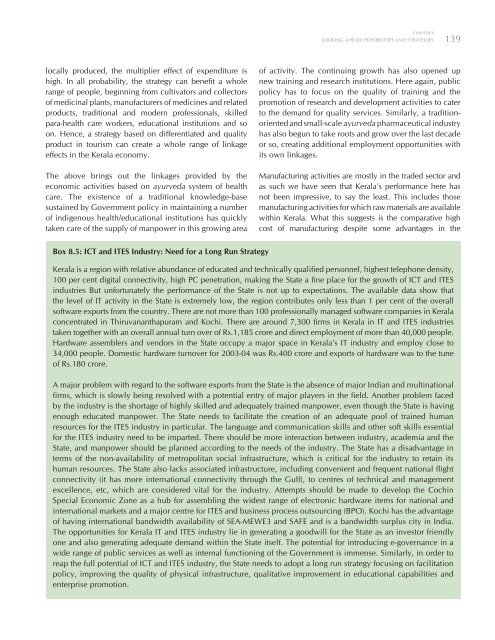Kerala 2005 - of Planning Commission
Kerala 2005 - of Planning Commission
Kerala 2005 - of Planning Commission
You also want an ePaper? Increase the reach of your titles
YUMPU automatically turns print PDFs into web optimized ePapers that Google loves.
CHAPTER 8<br />
LOOKING AHEAD: POSSIBILITIES AND STRATEGIES<br />
139<br />
locally produced, the multiplier effect <strong>of</strong> expenditure is<br />
high. In all probability, the strategy can benefit a whole<br />
range <strong>of</strong> people, beginning from cultivators and collectors<br />
<strong>of</strong> medicinal plants, manufacturers <strong>of</strong> medicines and related<br />
products, traditional and modern pr<strong>of</strong>essionals, skilled<br />
para-health care workers, educational institutions and so<br />
on. Hence, a strategy based on differentiated and quality<br />
product in tourism can create a whole range <strong>of</strong> linkage<br />
effects in the <strong>Kerala</strong> economy.<br />
The above brings out the linkages provided by the<br />
economic activities based on ayurveda system <strong>of</strong> health<br />
care. The existence <strong>of</strong> a traditional knowledge-base<br />
sustained by Government policy in maintaining a number<br />
<strong>of</strong> indigenous health/educational institutions has quickly<br />
taken care <strong>of</strong> the supply <strong>of</strong> manpower in this growing area<br />
<strong>of</strong> activity. The continuing growth has also opened up<br />
new training and research institutions. Here again, public<br />
policy has to focus on the quality <strong>of</strong> training and the<br />
promotion <strong>of</strong> research and development activities to cater<br />
to the demand for quality services. Similarly, a traditionoriented<br />
and small-scale ayurveda pharmaceutical industry<br />
has also begun to take roots and grow over the last decade<br />
or so, creating additional employment opportunities with<br />
its own linkages.<br />
Manufacturing activities are mostly in the traded sector and<br />
as such we have seen that <strong>Kerala</strong>’s performance here has<br />
not been impressive, to say the least. This includes those<br />
manufacturing activities for which raw materials are available<br />
within <strong>Kerala</strong>. What this suggests is the comparative high<br />
cost <strong>of</strong> manufacturing despite some advantages in the<br />
Box 8.5: ICT and ITES Industry: Need for a Long Run Strategy<br />
<strong>Kerala</strong> is a region with relative abundance <strong>of</strong> educated and technically qualified personnel, highest telephone density,<br />
100 per cent digital connectivity, high PC penetration, making the State a fine place for the growth <strong>of</strong> ICT and ITES<br />
industries But unfortunately the performance <strong>of</strong> the State is not up to expectations. The available data show that<br />
the level <strong>of</strong> IT activity in the State is extremely low, the region contributes only less than 1 per cent <strong>of</strong> the overall<br />
s<strong>of</strong>tware exports from the country. There are not more than 100 pr<strong>of</strong>essionally managed s<strong>of</strong>tware companies in <strong>Kerala</strong><br />
concentrated in Thiruvananthapuram and Kochi. There are around 7,300 firms in <strong>Kerala</strong> in IT and ITES industries<br />
taken together with an overall annual turn over <strong>of</strong> Rs.1,185 crore and direct employment <strong>of</strong> more than 40,000 people.<br />
Hardware assemblers and vendors in the State occupy a major space in <strong>Kerala</strong>’s IT industry and employ close to<br />
34,000 people. Domestic hardware turnover for 2003-04 was Rs.400 crore and exports <strong>of</strong> hardware was to the tune<br />
<strong>of</strong> Rs.180 crore.<br />
A major problem with regard to the s<strong>of</strong>tware exports from the State is the absence <strong>of</strong> major Indian and multinational<br />
firms, which is slowly being resolved with a potential entry <strong>of</strong> major players in the field. Another problem faced<br />
by the industry is the shortage <strong>of</strong> highly skilled and adequately trained manpower, even though the State is having<br />
enough educated manpower. The State needs to facilitate the creation <strong>of</strong> an adequate pool <strong>of</strong> trained human<br />
resources for the ITES industry in particular. The language and communication skills and other s<strong>of</strong>t skills essential<br />
for the ITES industry need to be imparted. There should be more interaction between industry, academia and the<br />
State, and manpower should be planned according to the needs <strong>of</strong> the industry. The State has a disadvantage in<br />
terms <strong>of</strong> the non-availability <strong>of</strong> metropolitan social infrastructure, which is critical for the industry to retain its<br />
human resources. The State also lacks associated infrastructure, including convenient and frequent national flight<br />
connectivity (it has more international connectivity through the Gulf), to centres <strong>of</strong> technical and management<br />
excellence, etc, which are considered vital for the industry. Attempts should be made to develop the Cochin<br />
Special Economic Zone as a hub for assembling the widest range <strong>of</strong> electronic hardware items for national and<br />
international markets and a major centre for ITES and business process outsourcing (BPO). Kochi has the advantage<br />
<strong>of</strong> having international bandwidth availability <strong>of</strong> SEA-MEWE3 and SAFE and is a bandwidth surplus city in India.<br />
The opportunities for <strong>Kerala</strong> IT and ITES industry lie in generating a goodwill for the State as an investor friendly<br />
one and also generating adequate demand within the State itself. The potential for introducing e-governance in a<br />
wide range <strong>of</strong> public services as well as internal functioning <strong>of</strong> the Government is immense. Similarly, in order to<br />
reap the full potential <strong>of</strong> ICT and ITES industry, the State needs to adopt a long run strategy focusing on facilitation<br />
policy, improving the quality <strong>of</strong> physical infrastructure, qualitative improvement in educational capabilities and<br />
enterprise promotion.

















